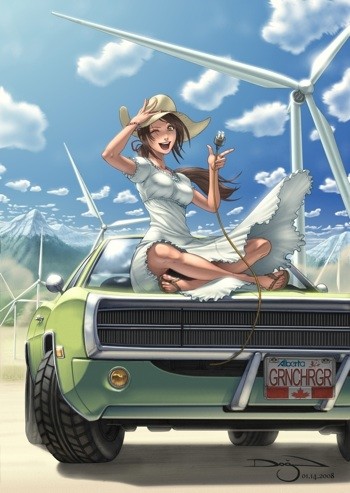The Gallery
Omar Dogan
by Evan Miller,
While writing this week's column, I found myself reminded of all the times I took on my brother in the old school Street Fighter II games for the Super Nintendo. I usually got accused of cheating, since I would just wail on my brother with kicks while he tried to hit all the buttons required to execute combos. He accused me of cheating, but I stand by the notion that if the game lets me win with a basic punch, I still win.
...and besides, once he was able to execute the combos quicker, I always lost. Ah, the karmic nature of video games...

The work of this week's artist has appeared on video game covers all over the world, published numerous comics, and has been one of the major forces behind the success of Udon Entertainment. Please welcome...
Imagine a job where you were regularly required to sacrifice sleep, time, and sanity for a month straight, with little - or zero - break time to speak of. For Udon Entertainment artist Omar Dogan, this kind of schedule is all too familiar. During his eight years as one of the key staff at Udon, Omar has been asked to produce entire comic issues - from sketches to colours - in just a month, and helped produce a 64 page piece for Marvel Comics in two weeks time. Despite the nightmarish schedule, Omar doesn't regret the workload he's been given. "People said that I couldn't make a living drawing manga-style art," he says, "but I stuck with my gut, and it paid off." In fact, as Omar described the trials and troubles of his career in art, I couldn't help but gain a sincere appreciation for his work ethic. Regardless of how one views his work, his intensity and love for the manga style has helped him carve a niche of his own in the comics world, not to mention given him a bevy of opportunities to develop his own artistic skills.
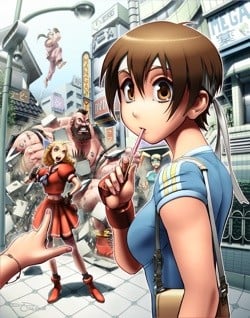 |
Sakura Legends Tribute |
Omar's roots in the world of art run deep. Raised in a low-income family near Toronto, Omar and his younger brother often received small gifts on birthdays and holidays - many of which were pencils, crayons, and other art related materials. These gifts appealed to Omar's artistic sensibilities early, and it wasn't long before he was spending day after day creating sketches and drawings in his free time. Even if the weather was perfect, he would spend many summer days in much the same way he spent the rainy ones: drawing inside the house. From early on, Omar's work developed a unique flavor. Although he had no exposure to anime or manga when he was young, he took an interest in drawing characters with large eyes and detailed facial expressions. He also worked on massive murals in pencil crayon, pressing hard to vary the depth and vibrancy of the colours he used. Unlike many of his peers in the art world, his parents were very supportive of their son's artistic abilities. When his mother first took an interest in art, her parents tried to deter her. Despite that, she kept up working on her art - and subsequently made sure that Omar and his younger brother grew up in an environment where the kind of pressure she faced was nonexistent. "She has always been supportive," remembers Omar, who also took an interest in other subjects and fields as he made his way through school. Although he was a dedicated student regardless of what he was working on, Omar knew that he wanted a future in art - but where?
The answer came in the early nineties, when a friend showed Omar the Satoshi Urushihara OAV Plastic Little. The art style appealed to him instantly, and it wasn't long before he would gather with friends regularly to watch untranslated episodes of Ranma 1/2 that a friend taped from Japanese TV. Although anime appealed to Omar, changes to his own art style were gradual at best. That would soon change, however, when he first saw the OVA anime Gunsmith Cats and You're Under Arrest. A fan of cars since his early years, Omar describes the detailed renderings of cars in the work of Kenichi Sonoda and Kosuke Fujishima as an eye-opening experience: "The level of detail in [Sonoda and Fujishima's] work influenced my style a lot... it drove me to strive for greater, sharper detail in all of my work." In terms of anatomy and muscle structure, Omar was most inspired by the work of Capcom's artist team and the art from the Street Fighter game series. Although many North American artists in the comics world were taking cues from the "superhero" comic genre when he was growing up, American comics never appealed to Omar ("I've never owned one," he admits). Instead, Omar felt more in tune with the focus on character development and storytelling at the center of many manga. "Masakazu Katsura's [I"s, Video Girl Ai] work was a huge influence on me," says Omar, who describes his exposure to anime and manga as a somewhat liberating experience. "It made me feel like it was okay to draw cute, simple things - and it showed me that there's a market for it."
Driven to make his work as intricate as the manga that inspired him, Omar applied to the Animation program at Sheridan College, which was only accepting 150 students at the time he applied. Despite tough competition and a sizeable applicant pool, he was accepted and quickly moved onto his next battle: convincing his professors to let him work with the manga style he loved. Although his professors tried to discourage him, he convinced them that he would still complete the coursework as they required. Sheridan allowed for very little adjustment time for Omar, who soon found himself working late into the night and driving to campus around 6AM to complete his work. The intense schedule left practically no time for a social life or work, so Omar often worked as a bus boy over the summer to save money he could use for essentials during the school year. Following his second year at Sheridan, Omar earned the envy of classmates when he was approached by Disney with a request for an interview. Even though it was an opportunity few people would pass on, he turned them down. Although the move shocked Omar's classmates, the decision made perfect sense to Omar: he wanted to work with the manga style, and working for Disney would deter him from that goal. Instead, Omar consulted with professors and decided to take another job that was offered to him: a position at a 3-D animation studio in Calgary. It would mean leaving school early, but Omar didn't mind: "Sometimes in art, the only piece of paper you need is the one you last drew on."
After two years at Sheridan, Omar was happy to be taking on a new set of challenges in his new job. Unfortunately, his joy was short-lived. The animation company that hired him went out of business, and soon after that Omar found himself back in Toronto, working in graphics to pay bills and trying to find an opportunity to return to a position that would enable him to keep taking steps toward his dream. He got a boost when he gathered a few friends and went to Wizard Con in Chicago, where he met the CEO of Toronto comic outfit Dreamwave. On a whim, Omar brought a profile of his work with him to Chicago, which he showed to Dreamwave. After a short chat, the publisher brought Omar aboard and enlisted him to help with a few of their titles. Thrilled to be working in his niche again, Omar contributed backgrounds to the Pat Lee series Warlands, and became a key member of the team for the second volume of the comic series Darkminds. The work was captivating for Omar, but unfortunately, history was due to repeat itself. In the summer of 2000, office politics began to affect staff morale at Dreamwave. Like many of the artists he worked with, Omar left the company soon afterwards. Although things were tough, the experience served as a reminder to Omar: if he kept working tirelessly on his art and stick to the manga style he loved, more opportunities would present themselves.
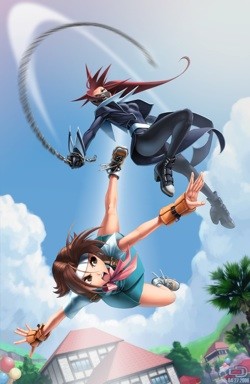 |
Hinata and Zaki |
Fortunately, he didn't have to wait long. In the summer of 2001, one of Omar's friends, Erik Ko, called him and asked for his help with a major project at his new start-up studio - a then small comics outfit called "UDON." The project was quiet massive: Marvel Comics needed 64 pages of Anime style artwork for a cross promotion with Burger King on their X-Men Evolution cartoon. However, the deadline was tight and the UDON group had less than one month to finish the task! Seeing the job as an opportunity, Omar and other artists gathered at Erik's house - a place that they later dubbed the "UDON Mansion" - to work day and night on the project. The sweat and tears paid off in a major way; Marvel was impressed with the results they got, and soon they asked UDON to work on more projects for them. As the reputation of the company grew, so did the list of clients, and it wasn't long before Omar was asked by UDON to become a full-time member of their creative team. Happy to be back in the line of work he was most comfortable with, Omar soon became one of the guiding voices over the future of UDON - a role where his perseverance would lead him to a very special opportunity.
After a few years of working for clients, UDON had the opportunity to sign a contract with Capcom for the Street Fighter property to do comics. At first, Omar was hesitant about the chance to work with the characters that helped inspire the style he had now been developing for a decade. The love of Street Fighter made them decide to take on this challenge and they signed the license. The company soon became the main publisher of all things Street Fighter, from original comics, to translated manga and art books. Capcom was impressed by the efforts of the UDON team, and the windfall they reaped made the Street Fighter gamble worth it. In fact, the art director of Capcom Japan is so impressed by the effort from the UDON artists that they were offered to participate in various video game jobs with Capcom, including the ending of Capcom Fighting Evolution, various promo and packaging art, and of course the biggest project of all – redrawing every pixel of the original Street Fighter II game in HD, where Omar is in charge of doing all the background art and animation. For Omar, the opportunity was a fan's dream come true: more than a decade after Capcom's characters had inspired him to forge his own path through the art world, he was being asked to help sketch their personal histories - with Capcom's blessing.
Today, Omar is the artist behind many of Udon Entertainment's most visible Street Fighter titles, including the Street Fighter Legends series. After gaining considerable attention for his work on the back story of the Street Fighter character Sakura, Omar is currently working on a Legends volume detailing the back story of the iconic Chun-Li character. The "murder mystery" flavor of the Chun-Li story is a change of pace from the lighthearted overtones of the Sakura volume, but Omar doesn't feel a lot of pressure to conform to certain standards for rendering the characters. "After a while, you inherently bring your own nuances to the work," says Omar, who's work has also been featured on video game covers for Konami all over the world. "You have your own idea of how Chun-Li should look, and that's how you draw it - from the personality you know." Omar's interpretation has certainly appealed to Capcom, not to mention the fans that continue to make the Street Fighter series Udon's most recognizable title. As for the artist himself, Omar is happy that years of hard work have given him the leverage to request more reasonable deadlines so he has time to devote to his wife and his personal life - but don't assume that Omar is going to stop working hard. "When you start trying to perfect something, it becomes an addiction," he says in reference to his art. "This style challenges me. I have ideals in mind, and I strive to reach those." One thing is certainly clear: as long as Omar Dogan holds a pencil, his hard work and dedication to the world of manga and comics will continue to inspire the artists that follow in his footsteps.

ANN: In your interview, we talked about the extreme amount of time that you have had to put into your work. As someone who's seen a comic through from start to finish, what are some of the steps of the process that require more time than a beginner might expect them to?
Omar Dogan: Layouts are key in figuring out the flow and gesture of the entire page / panel. The more time you invest into the rough work the easier the refining process will be. This is especially true with anatomy. Also keeping track of the backgrounds and details from page to page can be tedious. However, since you are the only person working on it, you know how you want it to look and know how you imagined it. Unless you can set up some sort of a mind-melding gadget, it is very hard to establish that same vision with another person involved in the process.
As a result of that, I almost never let my work out of my hands to be coloured or cleaned up. In the end it involves more thought throughout, but the package looks a lot more cohesive.
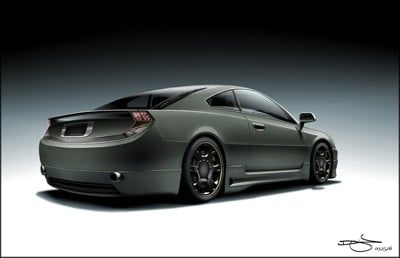 |
Coupe |
ANN: Your car artwork is extremely detailed. Which element do you draw first in pieces like this? Which kind of car model do you like sketching most?
Omar: Everything starts with perspective. If the perspective is off, it will show in the end when you highly render it. I rough it out on paper and scan it in. I always start with the silhouette of the car and work from there. I actually like drawing vans the most.
ANN: In working with the Street Fighter series, you've had to create a lot of action sequences. How do you develop these sequences, and have there been any notable inspirations on the way you render these sequences in sequential art?
Omar: I must say that the crazy way Arnold Tsang drew SF really forced me to loosen up. Fighting and action were not my strong points, and it took a lot of practice to break old habits. Chamba also uses highly contorted perspective shots and wild movements as well in his action sequences and it also pushes me to try and make it more extreme. I have a lot left to learn but I follow a few principles, like not using the same shots too often and moving the ‘camera’ around the fight. Also environmental factors can play into fight scenes making it more interesting and spontaneous. It should also be said that many of the fight scenes I have are scripted by the genius of Ken Siu Chong as well, so I am guided and directed as to what has to be drawn in a way.
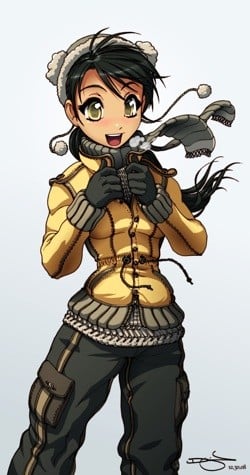 |
Snow Girl |
ANN: In your Deviant Art description of "Snow Girl," you mention that you have wanted to work with a "cute" style for quite some time. If you had the chance to use this style in a manga/comic series, is there a specific kind of storyline you would prefer to work with?
Omar: The thing that drew me into Manga / Anime was the availability of storylines that did not have to include superheroes in Speedos, so I would like to do something more realistic. Maybe something like a high school / university story. I find so many of the mainstream stories in North American comics have to be about fighting or looking bad-ass, and it's so contrived some times. At least with the SF series we tried to include lighthearted moments too.
ANN: What do you feel is the most important character trait an artist should have when working in the comic industry today?
Omar: Be timely, polite, and professional. There are millions out there like you and better, so stand out for good reasons. No one wants to hire a punk with an attitude and cool clothing no matter how good you think your art is.
Want to check out more of Omar's work? Good! Here's where to go:
Omar maintains his personal gallery on Deviant Art here. A lot of his work can be seen on the Udon Entertainment website, and a full listing of his print work for sale on Amazon can be found here.
Are you an aspiring manga artist looking for some extra page views? Do you have a friend or loved one who draws extremely good original manga but needs a boost? Don't just sit there! Submit two links to your work, including one original piece (no file attachments please! File attachments will be glued to a stick and become my umbrella, ella, ella, hey, hey, hey), to evan [at] animenewsnetwork dot com, and you could be featured in a future Gallery column!
All works © Omar Dogan.
discuss this in the forum (15 posts) |
this article has been modified since it was originally posted; see change history
